Submarine Defender (USA)
Immediately after the completion of the Argonaut program, Simon Lake’s company began developing several new submarine projects. Both samples should have a similar appearance, formed with the checks and use of existing submarines. At the same time, they had to have different onboard equipment and differ in their purpose. "Argonauts" in the existing form did not have any weapons and therefore did not suit the military department. For the naval forces, the Protector project was developed. The direct development of the previously used ideas, in turn, was to be the Defender submarine.
At the core of the Defender project was the designer’s desire to create a multi-purpose submarine capable of solving several diverse tasks, mostly non-military in nature. It was assumed that the boat of the new appearance will be able to patrol the specified areas and conduct reconnaissance. It was necessary to leave the hatch for an exit of divers, and also to equip the boat with torpedo tubes. The equipment already used in the form of a hatch for a diver was planned to be supplemented with a special airlock chamber. With its help, the submarine could solve rescue tasks. It was also proposed to ensure the possibility of working together with surface vessels for one purpose or another.
The management of the Lake Torpedo Boat Company believed that a promising Defender submarine would be able to interest the armed forces and various civilian customers. In the latter case, the boat could not be equipped with torpedo tubes, and the free volumes should have been used to house other units corresponding to the characteristics of the upcoming service. With this or that special equipment on board, the submarine could be used by commercial and scientific organizations.
Having extensive experience in the development and construction of small-sized submarines, S. Lake's company quickly completed the new project and began assembling the main structural elements. Preparation of documentation took only a few months, so 27 February 1906, the ceremony of laying a new boat at the shipyard Newport News Shipbuilding. By the end of 1907, the assembly of a strong and light body was completed, as well as the installation of the internal equipment corresponding to the original project. In the last months of 1907, the submarine was launched.
According to its design, the new Defender submarine to some extent resembled one of S. Lake's previous submarines, namely Argonaut II. At the same time, it was decided to remake the superstructure, located on a solid hull, which led to the appearance of a corresponding appearance, resembling the later submarines of American and foreign construction. With certain reservations, it can be argued that Defender was a landmark development for the entire industry and combined a number of key ideas that had not previously been used in a single project.
All major components and assemblies, as well as the crew were placed inside a metal durable hull. This unit occupied most of the total length of the boat and differed relatively complex shape. Its nose part had an ogival shape, smoothly mated with a cylindrical central section. The aft section of the hull differed smoothly tapering bypasses and ended with a pointed fairing. Like the previous projects, the cross section of the case was divided into two parts. The upper one contained habitable compartments, whereas the lower one served as a battery well and also had space for the installation of ballast tanks.
The bow of the solid hull was given over to accommodate two torpedo tubes and diving equipment, including a hatch for going outside. The cockpit and the engine compartment were placed in the center. The stern, in turn, was given under the third torpedo tube and part of the elements of the power plant.
On top of a strong case was placed the superstructure necessary for the installation of part of the units. The nose part of the superstructure significantly protruded in front of the main body, forming a kind of ship-like bow with bow. The central section of the superstructure was U-shaped and expanded near the center. The height of the unit varied depending on the shape of the body. From the central part of the superstructure deck there was a low deckhouse consisting of two main blocks of different heights. The narrow rear part of the superstructure was the basis for the installation of a vertical rudder. The horizontal planes, in turn, were fastened on a sturdy casing.
The Defender submarine was supposed to receive a gasoline-electric power plant, similar to that used in previous projects. The aft part of the hull was given for the installation of a pair of gasoline engines with generators and two electric motors associated with propellers. Also, the electrical systems included a set of several large and heavy batteries located in the lower part of the case.
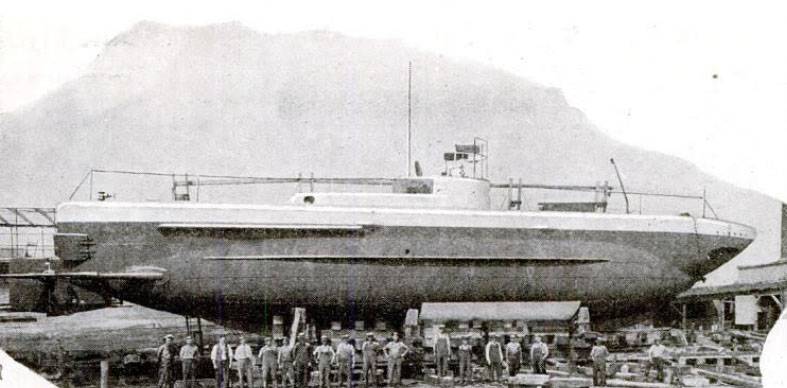
The boat shortly before going to the test. Photo by Popular Science magazine
The military did not want to acquire a submarine without any weapons. Similar requirements were previously taken into account in the draft of the Protector combat submarine, and now the Defender project was modified in a similar way. Armament promising multipurpose submarine consisted of three torpedo tubes caliber 457 mm. Two of them were placed in the nose compartment, the third - in the stern. Interestingly, to save internal volumes, most of the tubes of the nasal apparatus were placed outside of the robust housing. Inside there were only minor sections of pipes and covers. This arrangement of torpedo tubes led to the appearance of characteristic grooves in the sides of the nose of the superstructure. Ammunition could include up to five torpedoes: three in vehicles and up to two on the racks of the nose compartment.
Other weapons in the project was not provided. When creating other boats, the possibility of installing special retractable artillery installations was considered, but in the case of the new Defender, only torpedoes should be used.
To monitor the surrounding space and the surface situation, the crew had to use a set of windows in the wheelhouse. It also provided for the use of a periscope, also brought into the wheelhouse. Unlike some of S. Lake's previous submarines, the Defender did not have hull bow windows.
One of the main features of the submarines, developed by the Lake Torpedo Boat Company, was the availability of means to ensure the work of divers. Between the nose torpedo tubes there was a narrow passage ending in a hatch. The hatch cover opened to the outside and allowed the diver to reach the desired depth or to the bottom. The airlock was not used. The internal volumes of the submarine were protected from the ingress of water on the principle of a diving bell. On board the boat was proposed to transport a diving suit and a variety of tools.
Nose hatch was considered not only as an outlet for divers. With it, the submarine, as stated, could lay sea mines. It was proposed to transport ammunition ready for staging in the nose compartment of the hull and push it out through the existing hatch. According to some information, the question of creating special systems was also considered, with the help of which the crew could fight enemy mines without leaving the hull.
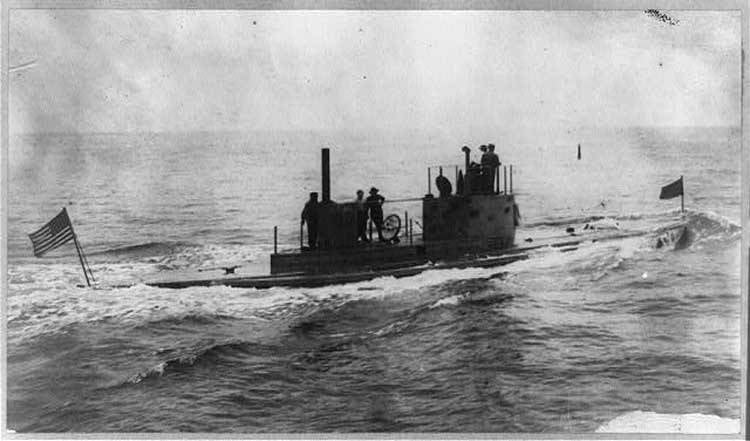
Defender in the sea. Photo Navsource.org
Subsequently, Simon Lake and his colleagues improved the complex of diving equipment, thanks to which the submarine had the opportunity to participate in search and rescue activities. In such situations, the Defender boat was supposed to use an additional airlock. It was a large cylindrical device having a bottom cover with a hatch and fastenings for installation on the bow of the submarine. The main task of such a camera was to ensure the rescue of sailors from sunken ships or submarines. It was assumed that those in distress — either alone or with the help of divers — would be able to climb into an additional chamber and from there move into a solid hull.
The regular crew of the submarine Defender consisted of ten people. They were supposed to monitor the work of the mechanisms in shifts and perform the assigned combat or other tasks. The living conditions on the boat were rather modest, however, in the available volumes, they still managed to accommodate several folding sofas for relaxing, a small-sized kitchen and other devices.
The Defender submarine had a length of 92 feet (28 m) and a maximum width of 13 feet (3,95 m). Displacement - a record for the development of S. Leyka 200 t. With the help of two electric motors that receive energy from gasoline generators, the submarine could reach speeds up to 7-8 nodes in the surface position. The durable hull allowed to dive to a depth of no more than a few tens of meters. The depths of the work of divers imposed more serious limitations.
The only Defender-type submarine was built by the Lake Torpedo Boat Company in 1907. Shortly after launching, the boat began tests, during which it was supposed to show the calculated technical characteristics, as well as to prove in practice the possibility of solving other problems. During the tests it was possible to do without any problems and difficulties. So, by this time S. Lake and his colleagues had time to check the torpedo armament used on the Protector submarine at sea polygons. In addition, there was already extensive experience in the use of submarines as a transport for divers. Thanks to all this, the submarin quickly confirmed all its capabilities and showed itself in the best possible way.
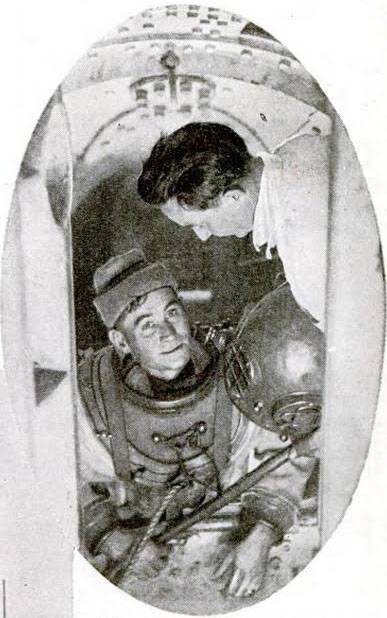
Diver Jack Gardner out through the bow hatch. Photo of Popular Science
After testing, the boat was offered to customers. First of all, representatives of the United States Navy received an opportunity to get acquainted with it. Like several years earlier, the military did not want to acquire such equipment. The armament already consisted of several types of submarines that had one or another difference from the Defender. Based on the combination of the pros and cons, the purchase of submarines S. Lake was considered inappropriate. In addition, some features of the submarine were severely criticized. So, the military again did not approve of the use of the bow hatch for landing divers. This unit was considered redundant and unnecessary. the fleet.
Due to the lack of interest from the main, as it was believed, customer, Simon Lake was forced to look for new potential buyers, as well as to take measures to attract attention. In particular, it was at this stage of the work that the creation of an additional airlock chamber began. Also, based on the desire to promote the boat in the civilian market, the authors of the project provided for the removal of torpedo tubes and the installation of various equipment. After such an upgrade, divers, going to the seabed, could use a variety of manual electric and pneumatic tools.
However, this update of the submarine did not allow finding potential buyers. S. Lake had to abandon the further development of the project, attempts to promote it on the market and hopes of receiving an order. The no longer needed submarine of the project has for some time not been regarded as a commercially viable development and is now used only as an experimental vessel. In addition, several times they tried to use it for bottom exploration.
After the resource was exhausted, the Defender submarine was moored. The prospects for the ship left much to be desired. In the very near future, the "Defender" could be written off and sent for recycling. Nevertheless, the fate of the boat was decided long enough, as a result of which she received a second chance.
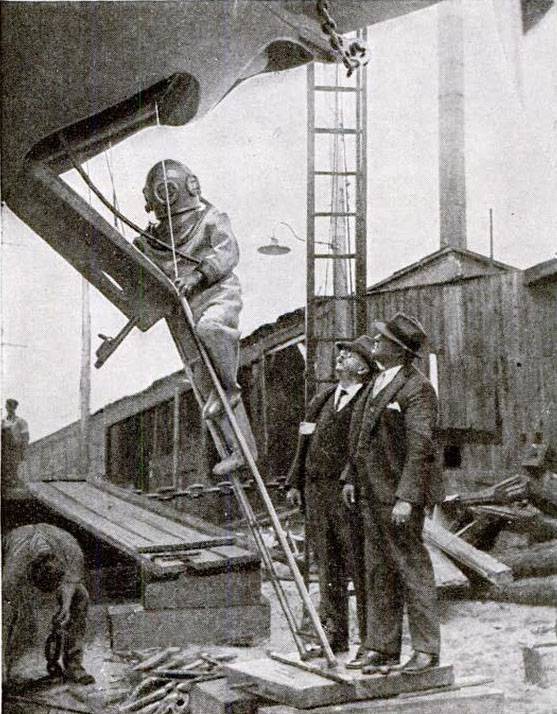
Demonstration of the exit of the diver to the seabed. Photo by Popular Science magazine
In 1928, explorer George Hubert Wilkins, who was preparing for the next expedition, ordered repairs and upgrades of an already forgotten submarine. The main structural elements were restored, the outdated equipment was replaced. The existing engines were replaced by new ones that developed 120 horsepower. each. Nevertheless, according to S.Lake's estimates, such a power plant did not fully meet the requirements of the times and features of the future campaign.
After the repair and modernization of the submarine Defender was supposed to sail in the Arctic seas. However, she never managed to take part in a scientific expedition. Shortly after the start of repair, the organizers of the future expedition found a more convenient transport for scientists. In 1930, the US Navy put up for sale a decommissioned submarine USS O-12 (SS-73), built as part of the so-called. O-series designed by S. Lake. It was distinguished by higher characteristics and therefore was of more interest to the team of J.H. Wilkins. As a result, O-12, later renamed to Nautilus, was sent for repair. Restoration of the "Defender" was stopped, and he was again sent to the sediment.
The further fate of the Defender submarine, which was the sole representative of its project, is not known for certain. From a certain time, it is not mentioned in any sources, which may indicate its disposal. However, information about the time of the write-off and the place of the cutting is not available. Anyway, one of the original designs of the Lake Torpedo Boat Company ceased to exist no earlier than the beginning of the thirties.
Having failed to interest civilian customers in projects of the Argonaut series, and also not having received an order for the construction of Protector submarines for the US Navy, Simon Lake tried to create a multipurpose submarine combining the main features of combat and research ships. This original problem was solved, but this solution could hardly be called successful. Despite the presence of a number of interesting features and certain positive features, the Defender submarine was never able to become the subject of a supply contract. The only boat of this type remained in the property of the manufacturer until the very end of its existence. However, this did not stop the initiative constructor, and soon submarines of new types were created.
On the materials of the sites:
http://simonlake.com/
http://pigboats.com/
http://navsource.org/
Risking Death for Invention. Popular Science. 1928, No. 12
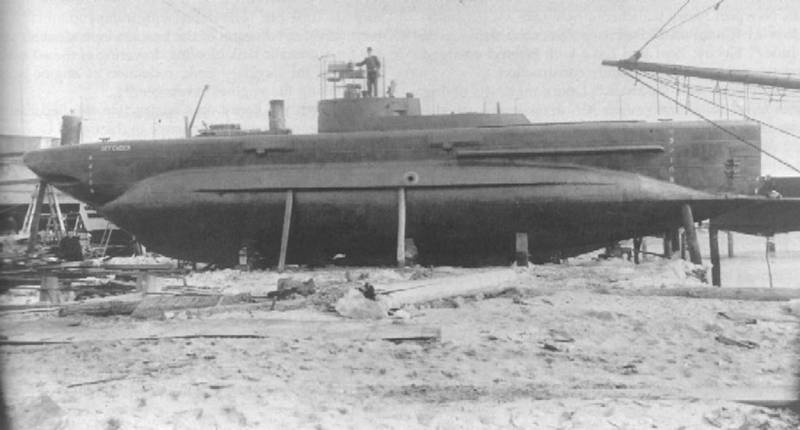

Information